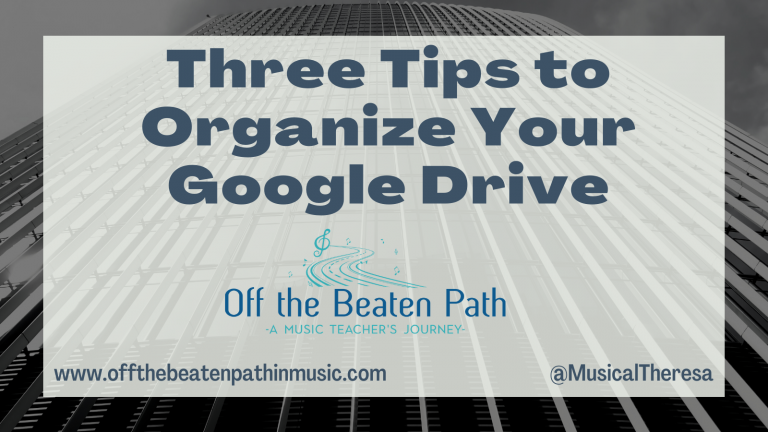Hidden Gems Within Google Arts & Culture
In 2011, Google launched their project, “Google Arts & Culture” as a partnership with 71 prominent museums around the world. Since then, it’s grown to include over 1,500 museums and cultural institutions – including several of interest to music educators! Throughout the Google Arts & Culture website, there are many components that music educators will find valuable for engaging and empowering their students.

At first glance, the website can appear overwhelming. The amount of content is vast and always growing. In this post, I’ll try to break down some of the main sections and share specific links that I’ve found useful.
Collections
One way you can search Google Arts & Culture is through the Collections. Collections are compilations of material from partner organizations (museums or cultural institutes) and can contain stories, online exhibits, images, videos, virtual tours, and more. The collections are from all over the world, not just the United States. Here are some of my favorites:
- Carnegie Hall, New York, USA – this collection includes 17 online exhibits about various artists who have performed at Carnegie Hall, along with a Street View tour of the venue, which you can explore in virtual reality!
- The National Music Museum, Vermillion, SD, USA – this collection includes two online exhibits, numerous instrument images, and a Street View tour of the museum.
- LA Phil, Los Angeles, USA – this collection includes seven online exhibits and many videos and images, including the Walt Disney Concert Hall!
- Sound and Music, London, United Kingdom – Sound and Music is an agency for new music with multiple online exhibits, images, videos, and tours.

Other noteworthy collections within Google Arts & Culture include The Museum of Modern Art, The National Gallery of Art in Washington DC, The National Gallery in London, and many more. The collections can help make cultural connections to music being studied.
Themes
Themes are built around specific topics and can contain content from a variety of sources and collections. Most themes have a lot of content in a variety of formats, including online exhibits, images, videos, Street View tours, and more. Some of my favorite themes include:
- Music, Makers, and Machines – a history of electronic music
- Beethoven Everywhere – connecting the music of Beethoven to pop culture
- Bob Marley: Legend – exploring the life and legacy of the reggae king

There are many other themes, including those around history, art, innovation, and culture. Exploring the various themes can be fun both inside and outside the music room!
360° Videos
One of my favorite things to do within Google Arts & Culture is watching the 360° videos. These videos make it feel like you are on stage with the musicians! You can find these videos in various collections and themes, or search the entire library of videos here: 360° Videos. Two of my favorites include the Philadelphia Orchestra in Carnegie Hall playing, In the Hall of the Mountain King, and Simon Rattle conducting the Berlin Philharmonic in a rehearsal of Beethoven: Symphony No. 9. As you watch the videos, use your mouse to move around the screen and enjoy the view!
Learn With Google Arts & Culture
Google Arts and Culture also includes a section for teachers, called Learn With Google Arts & Culture. Here you can download lesson plans to discover multiple topics, including musicians, composers, singers, orchestras, and instruments. From the Learning About Music theme you can explore several areas, or scroll down to find downloadable music lesson plans. Some notable lesson plans include:
- Inspirational Women in Music
- Black Music Sets the Beat
- Fryderyk Chopin
- A Brief History of Electronic Music
These lesson plans provide a great starting point for teaching, as they can be downloaded and adapted to fit the needs of your class.

Experiments With Google
Arts & Culture Experiments are projects that push the boundaries of arts, technology, and culture. Most experiments are interactive, allowing the user to explore, investigate, and create. The experiments can both be fun and educational for students.
- Seeing Music – experience music visually
- Chrome Music Lab – create music using a variety of tools
- Semi-Conductor – conduct an orchestra by moving your arms
- Paint With Music – turn your paintbrush into a musical instrument
- Blob Opera – create an opera song
- Play a Kandinsky – find out what it would be like if you could hear color
- FreddieMeter – challenge yourself to see how closely your singing matches that of Freddie Mercury (maybe not for students, but definitely fun!)

What Else?
It would be impossible to mention every feature of Google Arts & Culture in one blog post, but hopefully this has inspired you to dive in and explore. It’s worth noting that you can “Favorite” items, stories, and collections, saving them to your profile. You can also create “Galleries” to share with others. The search feature allows you to search the entire platform. It’s worth searching for a few keywords that relate to what you’re teaching, and see what you find!
How have YOU used Google Arts & Culture with your music students? Send me a message or leave a comment below!
If you’re looking for more ideas, check out these links:







